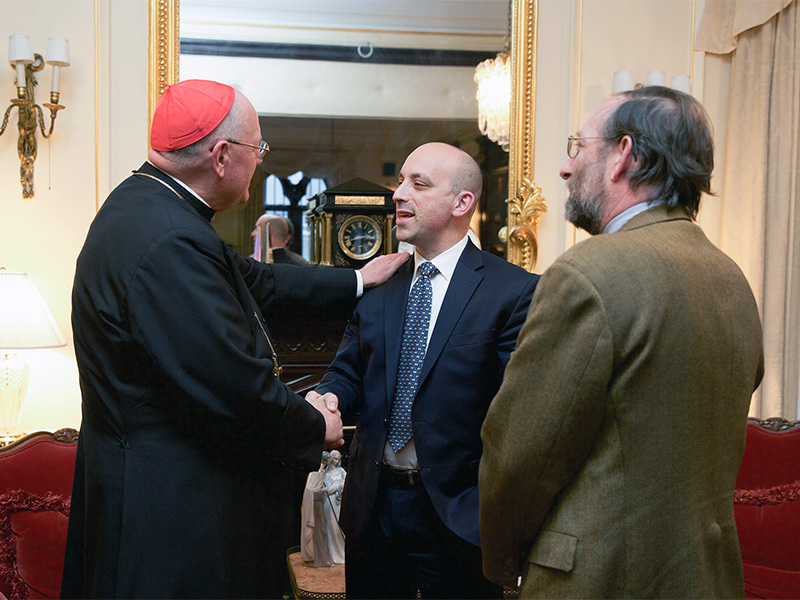NEW YORK (RNS) — Jonathan Greenblatt was working at the White House when he got a call from a headhunter wondering if he’d be interested in a job running the Anti-Defamation League.
She couldn’t be serious, he thought.
As director of the the Obama White House’s social innovation office, Greenblatt figured the headhunter didn’t really want him. She only wanted him to connect her to the right person.
After all, Greenblatt was a businessman. He had earned his stripes as an entrepreneur who started a handful of firms, including Ethos Water, the bottled water company now owned by Starbucks, which he co-founded with a business school classmate as a way to support water relief in the developing world.
“I thought, ‘ADL is a civil rights organization. I’m not a civil rights expert,” he said. “ADL is all lawyers. I’m not a lawyer. ADL is a Jewish organization. I’ve never worked in the Jewish community.’”
Still, his wife had worked as associate director of the ADL’s Los Angeles office before the couple moved to D.C. So as a courtesy, he decided to meet with the headhunter.
Three years later, he has become the public face of the ADL, his utterances about anti-Semitism and other forms of bigotry served daily through press releases, tweets, conferences and TV news spots. In that time, he has managed to distance his showman predecessor Abraham Foxman with a sober, studious and sometimes starchy demeanor railing against the dangers facing Jews and other minorities — the twin pillars of the ADL’s mission.
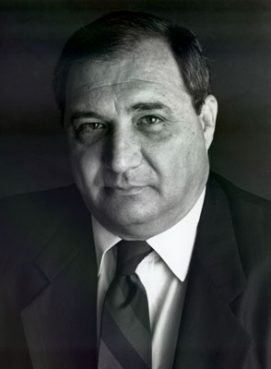
Abraham Foxman. Photo courtesy of ADL
Where Foxman was avuncular and often melodramatic, Greenblatt, 47, is businesslike and shrewd. Since taking over in July 2015, he has brought a business and marketing acumen capped by a tech-savvy sophistication to a 105-year-old nonprofit organization based in New York.
He opened a Silicon Valley office on top of the ADL’s 26 regional offices (plus one in Israel). He chose San Francisco as the venue for its second annual TED- style conference “Never Is Now,” drawing activists and leaders from Facebook, Twitter and other heavy hitters of high-tech to fight hate speech online. This year he is reorganizing the ADL’s unwieldy 300-member National Commission, creating a 17- to 23-member board of directors more line with other nonprofit organizations.
But if Greenblatt took the job thinking he could bring the ADL into the 21st century, history had a bigger plan. The presidency of Donald Trump and the rise of white nationalism — in the U.S. as well as abroad — have given him a challenge and a pulpit his predecessor never had.
The rebirth of nationalism in the form of neo-Nazi, alt-right and other far-right political activists has unleashed a wave of online vitriol and in some cases violent hate crimes directed at Jews, Muslims, blacks, Hispanics and immigrants.
In 2017 alone, anti-Semitism surged 57 percent, the largest single-year increase on record, as the ADL documented. At the same time, instances of left-wing anti-Semitism — such as the D.C. council member who suggested Jewish financiers control the weather or the Women’s March organizers’ support for Louis Farrakhan’s anti-Semitic rants, not to mention the British Labour Party’s Jeremy Corbyn problem — have also been rising.
[ad number=“1”]
Consider that the Republican candidate for Illinois’ 3rd Congressional District, Arthur Jones, is a self-declared Nazi and a Holocaust denier.
“What you’ve seen is a normalization of some of the worst kinds of rhetoric seeping into supposedly legitimate quarters,” Greenblatt said. “It’s really chilling.”
Greenblatt doesn’t have magical solutions. But he’s trying to tackle hate in novel ways — by forging strong ties with Muslims and other minority groups, partnering with the social media giants on efforts to reduce cyberhate and, where possible, galvanizing public opinion through campaigns such as the “Mayors’ Compact,” an ADL initiative that enlisted 300 U.S. mayors to commit to fighting hate and extremism.
‘Anti-Semitism doesn’t live in a vacuum’
His single most dramatic initiative may be his willingness to engage Muslims.
When the U.S. Senate considers President Trump’s choice to lead the State Department in a few weeks, the ADL will issue a list of critical questions for lawmakers to consider, as it does before many such confirmations.
Greenblatt has already said he has “serious concerns” about the fitness of Mike Pompeo to serve as secretary of state due to his “hostility to Muslims” and his track record trafficking in “anti-Muslim conspiracy theories.”
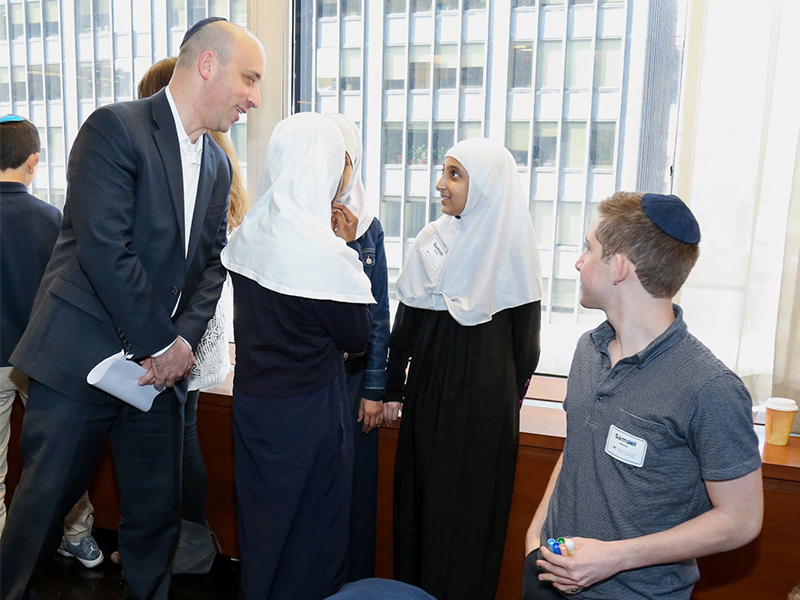
Jonathan Greenblatt, ADL CEO and national director, interacts with middle-school students from Muslim, Catholic and Jewish schools during an interfaith seder in Manhattan in April 2016. Photo courtesy of ADL
Founded to combat the mistreatment of Jews, the ADL is now defending Muslims from Islamophobia, too.
When Trump proposed a Muslim registry shortly before taking office, Greenblatt responded: “The day they create a Muslim registry is the day I register as a Muslim.”
He has also hired an Arab-American expert in countering violent extremism as senior vice president of programs.
George Selim, who worked for the Bush, Obama and Trump administrations in various roles, including directing the Countering Violent Extremism Task Force in the Department of Homeland Security and serving as a government liaison to the Muslim American community, now plays a big role at the ADL.
Selim directs the ADL’s Center on Extremism and oversees its education and law-enforcement training programs. The ADL reaches more than 1.5 million schoolchildren every year with its K-12 anti-bias, anti-hate educational programs. In conjunction with the United States Holocaust Memorial Museum, it also offers a one-day training to all FBI agents and many of the nation’s largest police departments on ways to fight extremism. (In March, for example, it trained the Seattle police force.)

George Selim. Photo courtesy of ADL
A Catholic of Egyptian and Lebanese descent, Selim said he was drawn to the ADL because of its commitment not only to combating anti-Semitism but also to securing justice and fair treatment for all.
“What makes working there such an appealing place for me to be post-government is that I can continue the mission of working on all forms of hatred and bigotry and extremism,” Selim said.
And while that emphasis on justice and fair treatment for all has been part of the ADL since its founding — back in the early years it was the cornerstone of black-Jewish relations — its ties to the Muslim community have not always been so sturdy.
Foxman famously opposed the Park51 Islamic Center, also known as the Ground Zero Mosque in lower Manhattan. He also praised Daniel Pipes, a prominent anti-Muslim commentator, and donated to his Middle East Forum.
Like his predecessor, Greenblatt remains opposed to the Iran nuclear deal. Partly, that may be because his wife, an Iranian Jewish refugee, was forced to escape the country in her teens wearing a hijab. And partly, it may be his desire to defend Israel from Iran’s militaristic obsession with destroying it.
But there’s little doubt that Greenblatt understands that hate begets hate and defending the rights of one group ultimately leads to defending the rights of others.
“The thing about the ADL is that it’s always understood that anti-Semitism doesn’t live in a vacuum,” said Jill Jacobs, executive director of T’ruah: The Rabbinic Call for Human Rights. “You can’t just fight anti-Semitism without fighting other kinds of racism.”
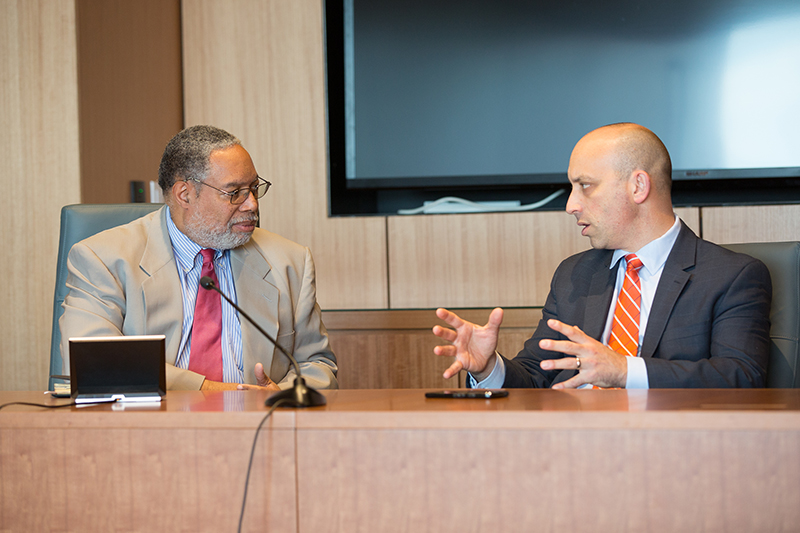
Jonathan Greenblatt, right, ADL CEO and national director, with Lonnie G. Bunch III, director of the Smithsonian’s National Museum of African American History and Culture, during a private tour of the museum on May 7, 2017. Photo courtesy of ADL
Hate’s new frontier
Even before Greenblatt assumed his role at the ADL, the organization had already realized that anti-Semitism’s reach extended far beyond swastikas spray-painted on Jewish day schools and overturned graves at Jewish cemeteries.
Anti-Semitism, like many other kinds of hate, lives and thrives on the internet.
In 2012, the ADL launched an anti-cyberhate working group with Silicon Valley’s tech giants: Facebook, Google/YouTube, Microsoft, Twitter and Yahoo. Two years later, the group issued a set of “best practices” for the industry.
But Foxman remained frustrated by his limited success with internet companies’ willingness to scrub hate and bigotry online.
“We have been talking to the geniuses at Palo Alto,” Foxman told JTA in 2013. “We have said to them, ‘Thanks, but no thanks. You developed a technology that has some wonderful things but also has unintended consequences.’”
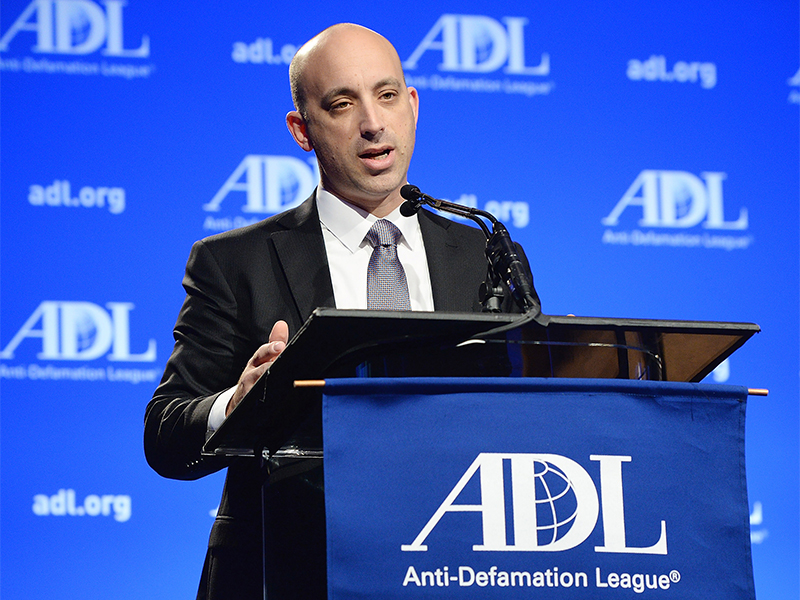
Jonathan Greenblatt. Photo courtesy of ADL/Michael Kovac
Greenblatt takes a different tack. His enthusiasm for new media marks him as a member of a younger generation, and his years of working in California — he started an open-source platform for volunteers called All for Good and served as CEO of the media company Good Worldwide — convince him partnering with the tech giants is the only way to go.
“Jonathan can bring his business background to say, ‘Look, I get you. How do we come up with a solution that benefits both you as well as the greater community?’” said Adlai Wertman, professor of social entrepreneurship at the Marshall School of the University of Southern California. “If you don’t understand what Facebook does for a living and what they value, then it’s impossible to move them.”
In 2016, Greenblatt opened a Center for Technology and Society in Silicon Valley and hired Brittan Heller, a former prosecutor from the Department of Justice’s legacy Nazi-hunting section who also served as a computer hacking and intellectual property specialist, to run it.
The center’s first act was to issue a report detailing a troubling, yearlong rise in anti-Semitic hate directed at mostly Jewish journalists on Twitter.
[ad number=“2”]
The 2016 report showed that a small number of user accounts — about 1,600 mostly white nationalists — attacked some 800 U.S. journalists with anti-Semitic and racial tirades on Twitter. That may seem like a small number, but Heller likened the online echo chamber of those tweets to the equivalent of buying a $20 million Super Bowl ad.
Twitter ultimately responded by suspending those accounts and changing its terms of service to make it easier for the social media giant to boot purveyors of hate.
Last year, YouTube announced a set of policies aimed at curbing extremist videos on the platform.
The ADL’s Silicon Valley office is now partnering with the University of California, Berkeley to create an algorithm that can discern the difference between hate speech and nonhate speech.
Recent developments have led many to wonder whether social media, which was intended to promote community and connection, has become too unwieldy and too dangerous for democracy. The fake news problems and the recent Cambridge Analytica scandal in which Facebook exposed data on 87 million of its users is giving many people pause about partnering with the media giants.
But Greenblatt is pragmatic.
“Frankly, NGOs like ours, on our own, will not solve the problem,” he said. “I think it’s going to take a combination of points of pressure. It takes political pressure, public pressure, the likes of which we can generate and other groups, and that ordinary people can generate. It also takes market pressure.”
And where Greenblatt can apply pressure, he will.
A nation of immigrants
For all his business know-how, Greenblatt is also deeply motivated by his Jewish identity and concern for Jewish continuity.
Growing up in Trumbull, Conn., he attended a Conservative synagogue and celebrated his bar mitzvah at 13. One member of his family, his grandfather, Bernard, had an outsize influence on him.
Bernard Greenblatt was born in Magdeburg, a central German city on the Elbe River with a Jewish population dating back to the 10th century. As a adult, he moved to east to Danzig (now Gdansk, Poland). In 1938 he made it to the U.S., settling in Bridgeport, Conn.
[ad number=“3”]
Greenblatt calls his grandfather a “Holocaust survivor,” and while Bernard escaped the the genocidal policies of the Third Reich, his experience as a refugee had a profound impact on Jonathan’s outlook.
As a college student at Tufts University, Jonathan Greenblatt spent a semester abroad visiting Magdeburg and other German cities, where he found no Jews. The realization was painful and when he returned to the United States he vowed he would work to stem anti-Semitism.
In his senior year, he found his way to the Boston office of the Anti-Defamation League and convinced the office’s director, legendary civil rights leader Leonard Zakim, to create an internship for him.
Greenblatt called that internship “life-changing.”
“I learned about hate crimes, anti-bias education,” he said. “I learned about interfaith events. They did a black-Jewish seder, which was amazing. It was a great experience.”
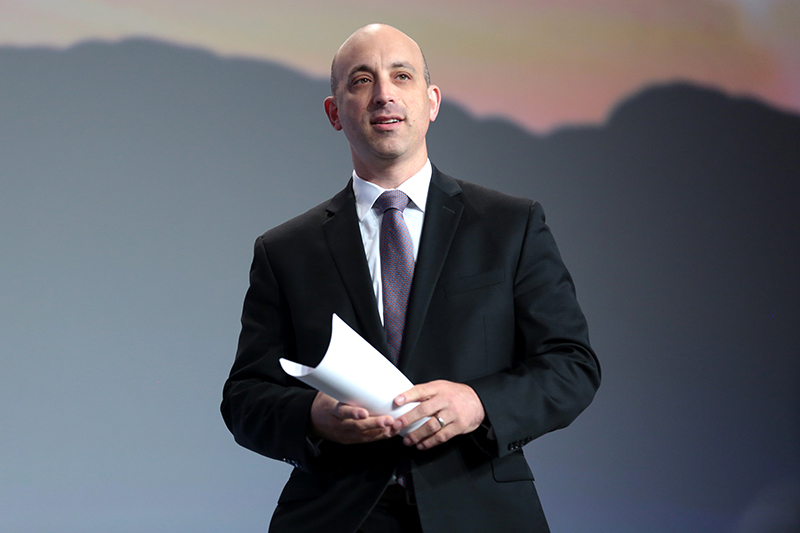
Jonathan Greenblatt speaks at the 2017 National Council of La Raza annual conference at the Phoenix Convention Center in Phoenix on July 10, 2017. Photo by Gage Skidmore/Creative Commons
Still, when college was over, Greenblatt enrolled at the Kellogg School of Management at Northwestern University and from there launched his business career. (In his first job he worked for Realtor.com.)
But it was an ADL connection from his college internship that led to an introduction to his wife, Marjan Keypour Greenblatt. After settling in Los Angeles, she worked as associate director of the Los Angeles ADL office; he briefly served on the board of the Jewish Community Foundation.
Though he may tell it differently, when the offer came to lead the ADL, there were plenty of personal touchstones that made the offer particularly attractive.
Three years in, most in the Jewish community praise the work he’s done.
Still, Greenblatt has had to fend off the fears of Jewish conservatives that he was an Obama liberal who would be insufficiently supportive of Israel — as some have accused the former president of being.
The Zionist Organization of America, which has sided with the Trump administration, including former aide Steve Bannon, has been his loudest critic.
But Greenblatt has also been targeted by Jews on the left, particularly those organizations working to end the occupation. Some of these activists consider Greenblatt too soft on Israel.
“I don’t think ADL is taking a partisan line,” said Jonathan Weisman, author of “(((Semitism))): Being Jewish in America in the Age of Trump” and a New York Times editor. “I actually think they should be more assertive.”
Greenblatt appears to have found a centrist Jewish voice. And many Jewish leaders are giving him credit for it.
“You have to call out your allies when they make excuses, whether it’s for Louis Farrakhan or Richard Spencer,” said Noam Neusner, who served as a speechwriter and liaison to Jewish communities for former President George W. Bush. “These are people who are corroding American life and turning America against itself. It’s a challenge. But I think Jonathan is up to it.”
Now Greenblatt wants to remind Jews of their immigrant story. He just wrote a foreword to John F. Kennedy’s 1958 classic, “A Nation of Immigrants,” which HarperCollins is reissuing later this year.
“The ADL is predicated on this idea that when America is good for the Jews, it’s good for all its people,” Greenblatt said. “When it’s good for all its people, it’s also good for its Jews.”
